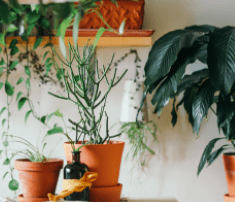6 Lighting Tips That Will Help Your Plants Grow Stronger

Like all living organisms, plants need nutrition to grow. This is mainly achieved by providing fertile soil, oxygen, water, and light. As house plant parents, you will need to acquaint yourself with the necessary methods to take care of your plants. Light is often an overlooked aspect despite playing a huge role in the photosynthesis process. This natural process occurs in plants to convert oxygen, water, and light into energy. If you take the lighting factor out of the equation, your plant does not get the energy needed for survival.
On that note, we bring you some vital lighting tips to help you grow your plants in a healthy way.
1. Understand The Types of Light
Light is an essential element for a plant’s growth. Lighting also varies in its types. So, learning about the disparity in its sources will help you decide what type to provide for your plants.
Natural Lighting
It is a no-brainer that our main source of natural light is the sun. However, such a source can differ depending on the time and location. Natural light is composed of four main categories: full sunlight, shade or partial sunlight, low light or shade, and indirect bright light. Each type has its benefits for certain plants. For example, full sunlight is not preferred by many plants, as it may damage them. Succulents and cacti can endure direct sunlight to gain from its benefits. For many plants and flowers, partial sunlight would be a great option for growth. In the case of low light, few plants would prefer to grow at that time, such as dragon plants and dragon trees. Without direct sunlight, most flowering and foliage plants require such type for photosynthesis. It can be achieved by placing the plants near windows in the early midday or sunset.
Artificial Lighting
While sunlight is the optimal source of light, artificial lighting has greatly accommodated the needs of plants. It is commonly used with indoor plants. The exposure to light varies from one plant to another, but plants need from seven to twelve hours of light on average per day. Technical experts at growlightinfo.com explain that because household lamps are not sufficient for plant growth, people buy fluorescent lights. Such lights are available in different shapes, styles, and colors, offering a wide variety of choices.
2. Ensure That The Light Is Received
Just because light enters a room, it does not mean that your plant is properly receiving it. As technology evolves, some coatings or panels on windows may not let the light pass through. This filters the needed lighting away from plants. If you have reflective or tinted glass, you should remember that your plant is not able to complete its energy-generating process.
3. Identify The Lighting Issues
Since you are trying to provide the right amount of a natural element as light, you may face some issues. It is better to be on the lookout for signs in case things go south. Instances of non-blooming flowers, weak and slow growth, and falling yellow leaves can indicate underexposure to light. On the other hand, overexposure to light can lead to the rapid wilting and death of flowers, drying of plants, and fading of the leaves’ colors. Other mild problems may arise like the growth of leaves and stems of plants on one side of the window. This happens because one side is more exposed to the light than the other.
4. Arrange Your Plants
As mentioned before, light is a delicate element to deal with. When you arrange your plants, you should place them in groups to offer various amounts of light to each one. Take into consideration that one plant may need more lighting than the other, so arrange accordingly. For example, you can place it at the front and then put the other plants in lowlight areas.
5. Know The Needed Quality
The light quality depends on its type and color. Since we have already covered the main types, we will get straight to the color variation. Like any type of energy, light energy varies in wavelengths, where each one has a corresponding color. We see light differently than plants, so what is useful for us may not be useful to them. Plants are green since they reflect that color; however, they need a variety of light colors to go through photosynthesis and make food.
6. Test The Light Quantity
To ensure that your plants are getting sufficient light, you should test it out. Simply, use a shadow test by taking a paper and hold it towards the light. If you find a sharp shadow, this means there is a bright light. The softer the shadow, the less light you will find. According to your results, place your plants to get a suitable amount of light.
Plants need food and water to survive. For them, light is an integral part of the food-making process, which is called photosynthesis. But in order for the plant to undergo the necessary chemical reactions, each plant needs a certain amount of lighting. With the guide provided here, you can apply helpful steps to take care of your house plants.




